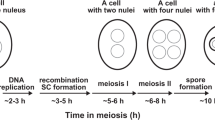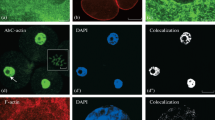Abstract
The ro-4 mutant of the filamentous fungus Neurospora crassa forms distinctive colonies in which hyphae grow into rope-like aggregates. This unusual morphology coincides with a defect in hyphal nuclear migration. The ro-4 gene was cloned from a cosmid library by complementation of the closely linked pab-2 gene. The deduced 380 amino acid protein is most similar to the vertebrate actin-related protein/centractin. The R04 protein is not essential for cell viability, and new strains created by inducing point mutations at the ro-4 locus have a phenotype which is very similar to that of the original mutant. This study provides genetic evidence that an actin-related protein plays a role in nuclear motility. Since nuclear motility is believed to be a microtubule-dependent process, the ro-4 gene product may function as a component of the dynactin complex which activates force generation by cytoplasmic dynein.
Similar content being viewed by others
References
Bruchez JJP, Eberle J, Russo VEA (1993) Regulatory sequences involved in the transcription of Neurospora crassa genes: CAAT box, TATA box, introns, poly(A) tail formation sequences. Fungal Genet Newsl 40:89–96
Clark SW, Meyer DI (1992) Centractin is an actin homologue associated with the centrosome. Nature 359:246–250
Clutterbuck AJ (1994) Mutants of Aspergillus nidulans deficient in nuclear migration during hyphal growth and conidiation. Microbiol 140:1169–1174
Davis RH, de Serres FJ (1970) Genetic and microbial research techniques for Neurospora crassa. Methods Enzymol 17A:79–143
Derksen J, Emons AM (1990)Microtubules in tip growth systems. In: Heath IB (ed) Tip growth in plant and fungal cells. Academic Press, San Diego, pp 148–182
Fidel S, Doonan JH, Morris NR (1988) Aspergillus nidulans contains a single actin gene which has unique intron locations and encodes a γ-actin. Gene 70:283–293
Garnjobst L, Tatum EL (1967) A survey of new morphological mutants in Neurospora crassa. Genetics 57:579–604
Gallwitz D, Sures I (1980) Structure of a split yeast gene: complete nucleotide sequence of the actin gene in Saccharomyces cerevisiae. Proc Natl Acad Sci USA 77:2546–2550.
Gill SR, Schroer TA, Szilak I, Steur ER, Sheetz MP, Cleveland DW (1991) Dynactin, a conserved ubiquitously expressed component of an activator of vesicle motility mediated by cytoplasmic dynein. J Cell Biol 115:1639–1650
Goldstein LSB, Vale RD (1992) New cytoskeletal liasons. Nature 359:193–194
Harold FM (1990) To shape a cell: an inquiry into the causes of morphogenesis of microorganisms. Microbiol Rev 54:381–431
Herman IM (1993) Actin isoforms. Curr Opin Cell Biol 5:48–55
Holmes KC, Popp D, Gebhard W, Kabsch W (1990) Atomic model of the actin filament. Nature 347:44–49
Holzbaur ELF, Hammarback JA, Paschal BM, Kavit NG, Pfister KK, Vallee RB (1991) Homology of a 150K cytoplasmic dyneinassociated polypeptide with the Drosophila gene Glued. Nature 351:579–583
Jacobs CW, Adams AEM, Szaniszlo PJ, Pringle JR (1988) Functions of microtubules in the Saccharomyces cerevisiae cell cycle. J Cell Biol 107:1409–1426
Kabsch W, Mannherz HG, Suck D, Pal EF, Holmes KC (1990) Atomic structure of the actin:DNAse I complex. Nature 347:37–44
Kawasaki ES (1990) Amplification of RNA. In: Innis MA, Gelfand DH, Sninsky JJ, White TJ (eds), PCR protocols: a guide to methods and applications. Academic Press, San Diego, pp 21–27
Kormanec J, Schaaff-Gerstenschlager I, Zimmermann FK, Parecko D, Küntzel H (1991) Nuclear migration in Saccharomyces cerevisiae is controlled by the highly repetitive 313 kDa NUMI protein. Mol Gen Genet 230:277–787
Lees-Miller JP, Henry G, Helfman DM (1992a) Identification of act2, an essential gene in the fission yeast Schizosaccharomyces pombe that encodes a protein related to actin. Proc Natl Acad Sci USA 89:80–83
Lees-Miller JP, Helfman DM, Schroer TA (1992b) A vertebrate actin-related protein is a component of a multisubunit complex involved in microtubule-based vesicle motility. Nature 359:244–246
Lloyd CW, Pearce KJ, Rawlins DJ, Ridge RW, Shaw PJ (1987) Endoplasmic microtubules connect the advancing nucleus to the tip of legume root hairs, but F-actin is involved in basipetal migration. Cell Motil Cytoskel 8:27–36
Marathe S, Connerton IF, Fincham JRS (1990)Duplicationinduced mutation of a new Neurospora crassa gene required for acetate utilization: properties of the mutant and predicted amino acid sequence of the protein product. Mol Cell Biol 10:2638–2644
McConnell SJ, Yaffe MP (1992) Temperature-sensitive yeast mutants defective in mitochondrial inheritance. J Cell Biol 118:385–395
McConnell SJ, Yaffe MP (1993) Nuclear and mitochondrial inheritance in yeast depends on novel cytoplasmic structures defined by the MDM1 protein. Science 260:687–689.
Meluh PB, Rose MD (1990) KAR3, a kinesin-related gene required for yeast nuclear fusion. Cell 60:1029–1041.
Morris NR (1976) Mitotic mutants of Aspergillus nidulans. Genet Res 26:237–254
Oakley BR, Morris NR (1980) Nuclear movement is beta-tubulin dependent in Aspergillus nidulans. Cell 19:255–262
Osmani AH, Osmani SA, Morris NR (1990) The molecular cloning and identification of a gene product specifically required for nuclear movement in Aspergillus nidulans. J Cell Biol 111:543–551
Palmer RE, Sullivan DS, Huffaker T, Kohland D (1992) Role of astral microtubules and actin in spindle orientation and migration in the budding yeast, Saccharomyces cerevisiae. J Cell Biol 119:583–593
Perkins DD, Radford A, Newmeyer D, Bjorkman M (1982) Chromosomal loci of Neurospora crassa. Micorbiol Rev 46:426–570
Read EB, Okamura HH, Drubin DG (1992) Actin- and tubulindependent functions during Saccharomyces cerevisiae mating projection formation. Mol Biol Cell 3:429–444
Reinert WR, Patel VB, Giles NH (1981) Genetic regulation of the qa gene cluster of Neurospora crassa: induction of qa messenger ribonucleic acid and dependency on qa-1 function. Mol Cell Biol 1:829–835
Reisler E (1993) Actin molecular structure and function. Curr Opin Cell Biol 5:41–47
Revardel E, Aigle M (1993) The NUM1 yeast gene: length polymorphism and physiological aspects of mutant phenotype. Yeast 9:495–506
Sambrook J, Fritsch EF, Maniatis T (1989) Molecular cloning: a laboratory manual. Cold Spring Harbor Laboratory Press, Cold Spring Harbor, New York
Schatten G (1982) Motility during fertilization. Int Rev Cytol 79:59–163
Schatten G, Schatten H, Bestor TH, Balczcon R (1982) Taxol inhibits the nuclear movements during fertilization and induces asters in unfertilized sea urchin eggs. J Cell Biol 94:455–465
Schwob E, Martin RP (1992) New yeast actin-like gene required late in the cell cycle. Nature 355:179–182
Schroer TA, Sheetz MP (1991) Two activators of microtubule-based vesicle transport. J Cell Biol 115:1309–1318
Schroer TA, Steuer ER, Sheetz MP (1989) Cytoplasmic dynein is a minus end-directed motor for membranous organelles. Cell 56:937–946 (1989)
Selker EU, Garrett PW (1988) DNA sequence duplications trigger gene inactivation in Neurospora crassa. Proc Natl Acad Sci USA 24:579–613
Selker EU (1990) Premeiotic instability of repeated sequences in Neurospora crassa. Annu Rev Genet 24:579–613
Sheterline P, Sparrow JC (1994) Actin. Protein Profiles 1:13–32
Skoufias DA, Scholey JM (1993) Cytoplasmic microtubule-based motor proteins. Curr Opin Cell Biol 5:95–104
Staben C, Jensen B, Singer M, Pollock J, Schechtman M, Kinsey J, Selker E (1989) Use of a bacterial hygromycin B resistance gene as a dominant selectable marker in Neurospora crassa transformation. Fungal Genet Newsl 36:79–81
Stevens JN, Metzenberg RL (1982) Preparing Neurospora DNA: some improvements. Neurospora Newsl 28:20–21
Trinci APJ (1978) The duplication cycle and vegetative development in moulds. In: Smith JE, Barry DR (eds) The filamentous fungi, vol 3. Edward Arnold, London, pp 132–163
Vollmer SJ, Yanofsky C (1986) Efficient cloning of genes of Neurospora crassa. Proc Natl Acad Sci USA 83:4869–4873
Xiang X, Beckwith SM, Morris NR (1994) Cytoplasmic dynein is involved in nuclear migration in Aspergillus nidulans. Proc Natl Acad Sci USA 91:2100–2104
Zaloker M, Erk I (1976) Division and migration of nuclei during early embrogenesis of Drosophila melanogaster J Microbiol Cell 25:97–106
Author information
Authors and Affiliations
Rights and permissions
About this article
Cite this article
Robb, M.J., Wilson, M.A. & Vierula, P.J. A fungal actin-related protein involved in nuclear migration. Molec. Gen. Genet. 247, 583–590 (1995). https://doi.org/10.1007/BF00290350
Received:
Accepted:
Issue Date:
DOI: https://doi.org/10.1007/BF00290350




